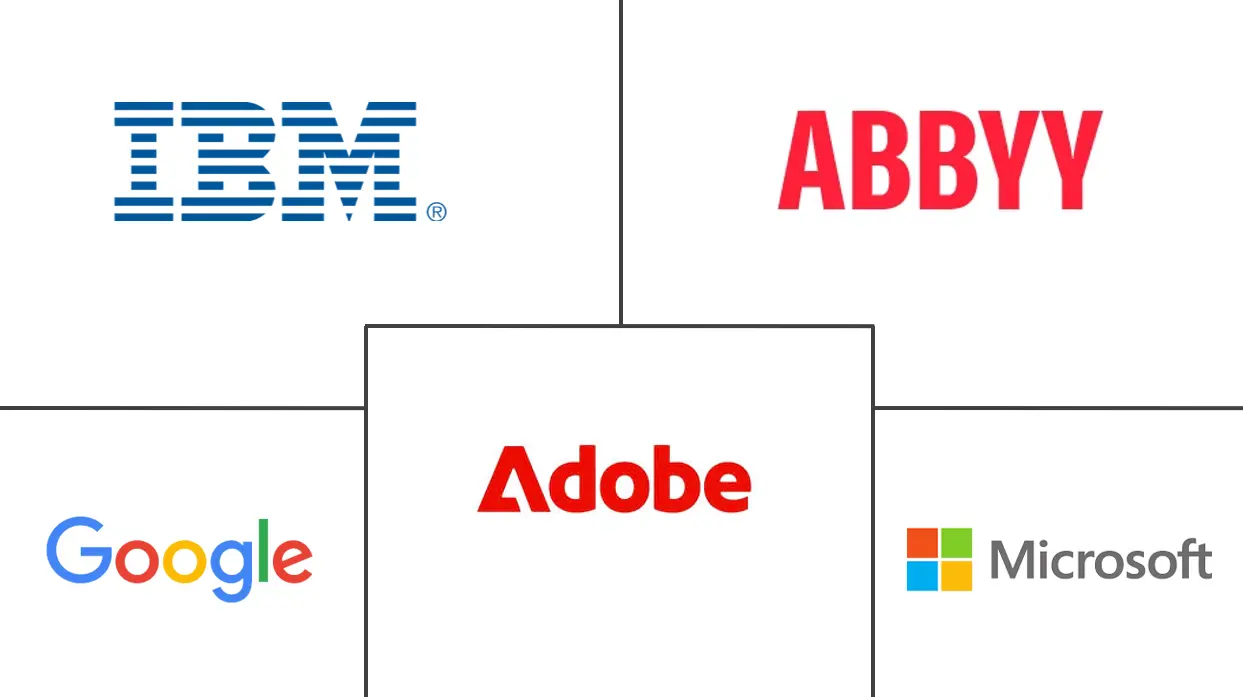Optical Character Recognition Market Size and Share
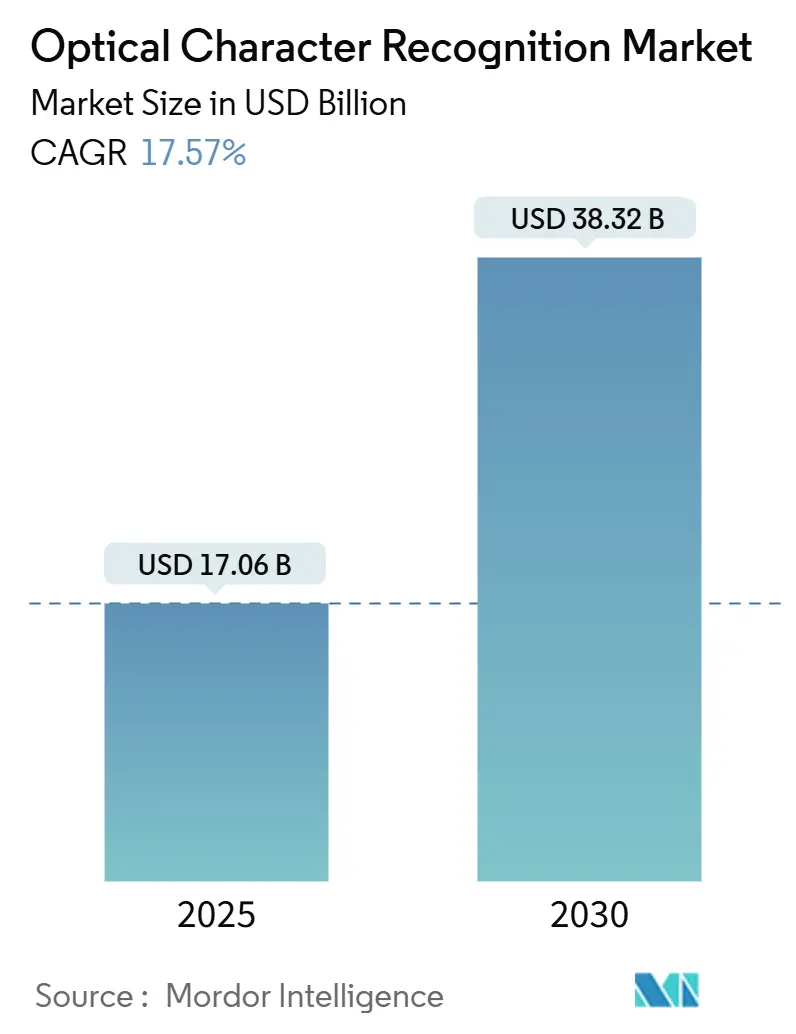
Optical Character Recognition Market Analysis by Mordor Intelligence
The optical character recognition market is valued at USD 17.06 billion in 2025 and is forecast to reach USD 38.32 billion by 2030, reflecting a 17.57% CAGR. Growth is propelled by AI-driven accuracy gains, expanding cloud deployment, and tighter regulatory mandates that encourage automated compliance checks. Technology vendors are shifting from standalone OCR engines to full-stack document-intelligence platforms that combine recognition, classification, and validation in a single workflow. Multimodal large language models, which read both images and text, are lowering per-page processing costs and widening adoption across small and midsize enterprises. Intensifying competition is pushing suppliers to differentiate through domain-specific templates, language support, and value-added analytics rather than pure extraction speed.
Key Report Takeaways
- By component, Software led with 78% revenue share in 2024, while Services is projected to expand at a 17.9% CAGR through 2030.
- By deployment Mode, Cloud accounted for 66% of the optical character recognition market share in 2024; On-Premise solutions are growing fastest at 15.8% CAGR to 2030.
- By technology, Conventional OCR retained 71% share in 2024; Intelligent Character Recognition is advancing at a 19.4% CAGR over the outlook period.
- By application, Invoice and Bill Processing held 33% of the optical character recognition market size in 2024, whereas Identity Verification and KYC is forecast to grow at 18.2% CAGR.
- By end-use industry, BFSI commanded 26% share of the optical character recognition market size in 2024, but Healthcare is set to post the highest CAGR at 20.2%.
- By geography, North America led with 40% revenue share in 2024, yet Asia-Pacific is projected to rise at 17.7% CAGR to 2030.
Global Optical Character Recognition Market Trends and Insights
Drivers Impact Analysis
| Driver | (~) % Impact on CAGR Forecast | Geographic Relevance | Impact Timeline |
|---|---|---|---|
| Rising automation in industries | +3.5% | North America, Europe | Medium term (2-4 years) |
| Adoption of cloud technology | +2.8% | North America (early), global | Short term (≤ 2 years) |
| Integration with IDP platforms | +2.1% | North America, Europe, advanced Asia-Pacific | Medium term (2-4 years) |
| AI-powered OCR for healthcare claims | +1.9% | North America, Europe, advanced Asia-Pacific | Medium term (2-4 years) |
| Accessibility-compliance regulations | +1.4% | North America, Europe, emerging Asia-Pacific | Long term (≥ 4 years) |
| Low-code OCR SDK uptake by SMBs | +1.2% | Emerging markets worldwide | Short term (≤ 2 years) |
| Source: Mordor Intelligence | |||
Rising automation in industries
Manufacturing and logistics organizations are embedding AI-driven OCR in supply-chain workflows to capture data from shipping labels, invoices, and pick-lists in real time. Accuracy levels of 97% under challenging lighting conditions increase throughput and cut manual touchpoints by 50% [1]Zebra Technologies, “A Deeper Dive on Deep Learning OCR,” zebra.com. Automatic number-plate recognition aligns with warehouse gates to speed vehicle entry, demonstrating how the optical character recognition market extends beyond documents to physical assets.
Adoption of cloud technology
Consumption-based cloud OCR removes up-front capital requirements and delivers instant algorithm updates. Azure Form Recognizer exemplifies this shift, providing pay-as-you-go pricing that attracts firms with variable document volumes. Browser-based engines using WebAssembly process IDs locally to satisfy privacy rules, allowing SMEs in stringent jurisdictions to benefit from cloud scalability without sending data off-site.
Integration with IDP platforms
Vendors bundle OCR, classification, and validation into end-to-end intelligent document processing suites. ABBYY FlexiCapture offers pre-built templates for mortgage applications and healthcare claims, reducing processing times by 80% and error rates by 95% [2]ABBYY, “Recent News & Activity,” abbyy.com. This platform orientation positions the optical character recognition market as a linchpin of broader automation strategies.
AI-powered OCR for healthcare claims
Healthcare payers automate extraction from explanation-of-benefit forms to structured ERA files, accelerating reimbursement and lowering administrative overhead. HIPAA-compliant security frameworks ensure protected health information remains encrypted throughout the workflow, addressing a critical adoption barrier.
Restraints Impact Analysis
| Restraint | (~) % Impact on CAGR Forecast | Geographic Relevance | Impact Timeline |
|---|---|---|---|
| High initial investment costs | -1.2% | Emerging markets, SMBs | Short term (≤ 2 years) |
| Data-privacy concerns in cloud OCR | -0.8% | Europe, regulated sectors worldwide | Medium term (2-4 years) |
| Low-resource language handwriting limits | -0.7% | Asia-Pacific, MEA, LATAM | Long term (≥ 4 years) |
| GPU supply constraints for deep-learning OCR | -0.5% | Global | Short term (≤ 2 years) |
| Source: Mordor Intelligence | |||
High initial investment costs
Enterprise-grade OCR deployments entail software licenses, systems integration, and process re-engineering that many SMEs struggle to afford. While subscription pricing mitigates capex, customizing workflows and linking legacy systems keep total cost of ownership high, slowing penetration in price-sensitive segments.
Data-privacy concerns in cloud OCR
European Data Protection Board guidance underscores risks linked to processing sensitive personal data with OCR, compelling many financial and healthcare entities to retain on-premise engines despite higher maintenance overhead. Vendors respond by offering containerized deployments and in-browser processing to balance efficiency and compliance.
Segment Analysis
By Component: Services Growth Outpaces Software Dominance
The software segment held a 78% revenue stake in 2024, establishing a solid base for the optical character recognition market. Services, however, are projected to deliver a 17.9% CAGR through 2030 as organizations demand consulting, customization, and managed operations to realize full ROI. This pivot shows that expertise, not merely code, now unlocks the value of OCR deployments.
Professional-services providers build vertical playbooks that embed industry terminology and regulatory templates into OCR pipelines. Healthcare integrators, for instance, supply medical lexicons to raise extraction precision, whereas banking specialists focus on AML and KYC documents. Managed services relieve internal IT teams from tuning recognition models, ensuring the systems stay current with new document formats.
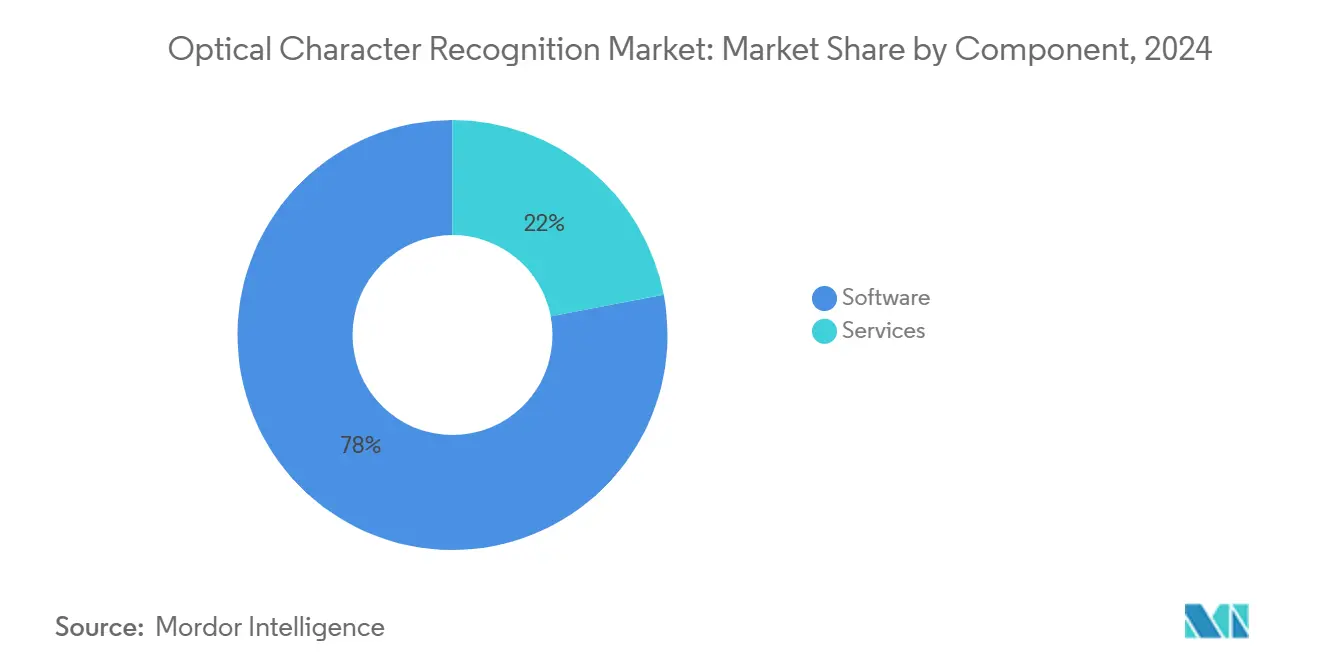
By Deployment Mode: Cloud Leads While On-Premise Gains Strategic Importance
Cloud deployments generated 66% of 2024 revenue, reflecting customer preference for elastic scaling and automatic algorithm improvements. Even so, on-premise solutions are set to rise at 15.8% CAGR as regulated sectors require data residency. Financial institutions often keep cheque imaging on local servers while shifting less sensitive workflows to the cloud.
Hybrid architectures dominate. Microsoft ships its OCR containers to customer data centers, letting firms process documents locally and still connect to Azure AI for advanced post-processing. This configuration positions the optical character recognition market as both a SaaS and an appliance play, depending on compliance thresholds.
By Technology: Intelligent Character Recognition Disrupts Traditional OCR
Conventional OCR retained 71% of 2024 revenue, yet Intelligent Character Recognition is forecast to advance 19.4% CAGR because it deciphers cursive scripts and semi-structured forms. Deep-learning ICR engines now hit 85% accuracy on clear handwriting, expanding the addressable workload beyond typed invoices.
Optical mark and intelligent word recognition modules complement ICR, processing check-boxes and short free-text notes. Multimodal AI models, capable of reading entire document layouts, further erode the distinction between OCR and natural language processing, creating a convergence zone that redefines the optical character recognition market.
By Application: Identity Verification Emerges as Growth Leader
Invoice and bill processing kept 33% share in 2024, anchoring core demand, while Identity Verification and KYC is projected to scale at 18.2% CAGR. Banks and fintechs integrate OCR with facial recognition to authenticate documents during mobile onboarding, cutting customer acquisition times from days to minutes.
Document management, although mature, remains essential as firms digitize archives for searchability. Packaging and label recognition leverages OCR for traceability across manufacturing lines, while healthcare providers combine OCR with clinical NLP to code unstructured notes. These specialized cases expand the optical character recognition market beyond accounts-payable hubs.
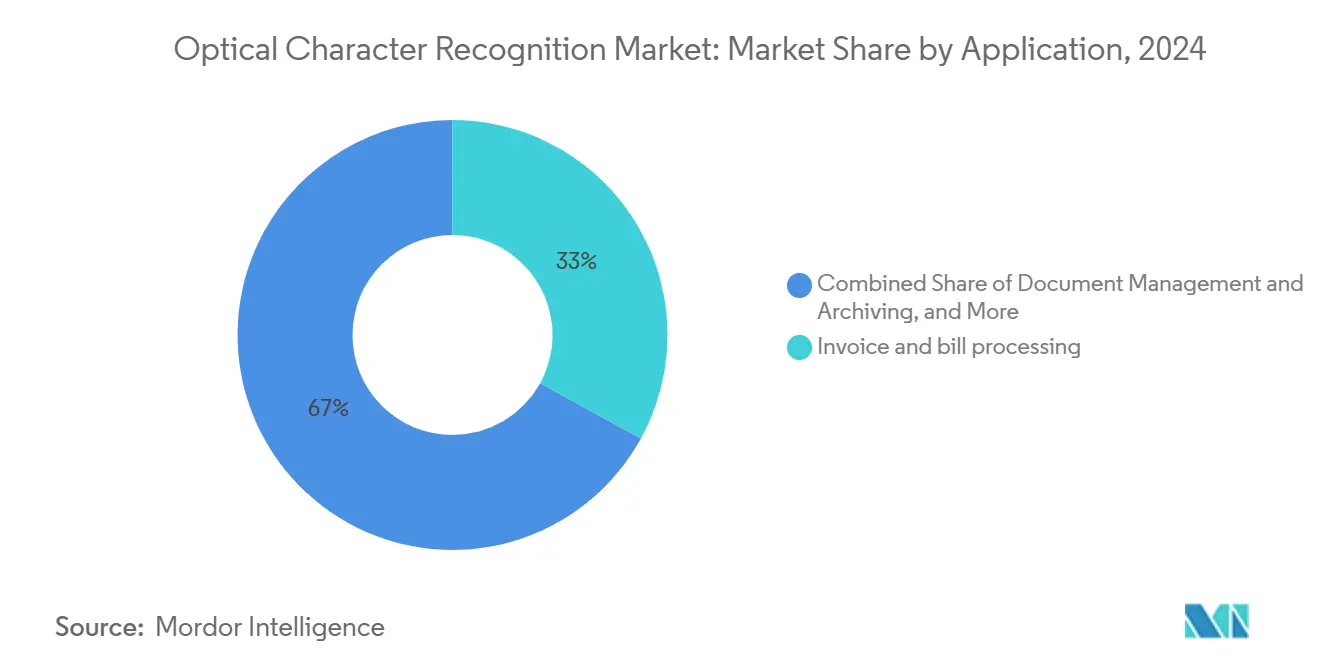
Note: Segment shares of all individual segments available upon report purchase
By End-Use Industry: Healthcare Digitization Drives Fastest Growth
BFSI controlled 26% revenue in 2024 through loan files, statements, and compliance records. Healthcare is poised for a 20.2% CAGR, fueled by electronic health-record mandates and the need to automate claims. OCR engines trained on clinical vocabularies extract diagnosis codes directly from scanned charts, improving billing accuracy.
Retail and e-commerce businesses employ OCR for product-label capture and customer ID checks at pickup points. Government agencies digitize land records and passports to modernize citizen services. Manufacturing plants embed OCR in quality-control stations, ensuring regulatory labels match batch data.
Geography Analysis
North America commanded 40% of optical character recognition market revenue in 2024, underpinned by high labor costs that justify automation and by a dense cluster of technology suppliers. HIPAA and KYC regulations accelerate adoption in healthcare and banking. Vendors in the region integrate OCR with robotic-process-automation bots, generating compound efficiency gains.
Asia-Pacific is the fastest-growing territory at 17.7% CAGR. China’s cloud providers, such as Alibaba Cloud and Tencent Cloud, bundle recognition services with broader AI suites, lowering entry barriers for local firms. India’s digitization programs and high-volume banking sector create fertile ground for KYC OCR, while Japan and South Korea focus on manufacturing quality control.
Europe shows strong uptake across public and private sectors but remains cautious on data sovereignty. Germany and France favor on-premise or sovereign-cloud installations to meet GDPR. Supply-chain resiliency goals push logistics firms toward automated document capture for end-to-end visibility, sustaining steady growth in the region.
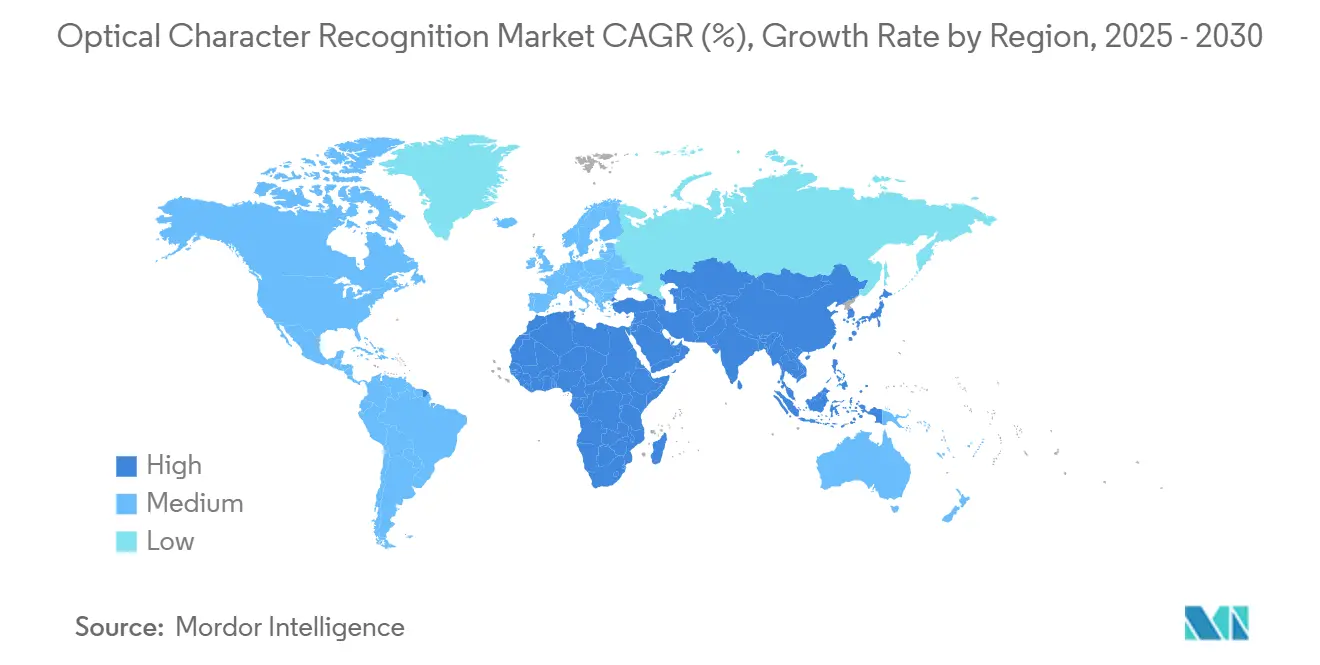
Competitive Landscape
The optical character recognition market features a mix of diversified software giants and niche AI entrants. Adobe, Google, and Microsoft embed OCR into broader productivity suites, offering wide reach. ABBYY, Kofax, and UiPath differentiate through vertical templates and workflow orchestration. Startups such as Mistral AI use large language models to reach 99% accuracy at USD 1 per 1,000 pages, raising the competitive bar [3]Campus Technology, “Mistral AI Introduces AI-Powered OCR,” campustechnology.com.
Strategic moves include API launches for developer ecosystems, acquisitions that add regulatory expertise, and containerized deployments for edge processing. Descartes Systems Group’s purchase of OCR Services expands trade-compliance coverage, while ABBYY’s new API targets low-code integration. White-space remains in low-resource language support and blockchain-verified document authenticity.
As vendors converge on similar deep-learning techniques, differentiation shifts to pre-built domain knowledge, governance features, and total cost of ownership. Partnerships with hyperscale clouds and RPA platforms extend market reach, keeping competition active yet preventing monopolistic dominance.
Optical Character Recognition Industry Leaders
-
ABBYY Software Ltd.
-
Google LLC
-
IBM Corporation
-
Microsoft Corporation
-
Adobe Inc.
- *Disclaimer: Major Players sorted in no particular order
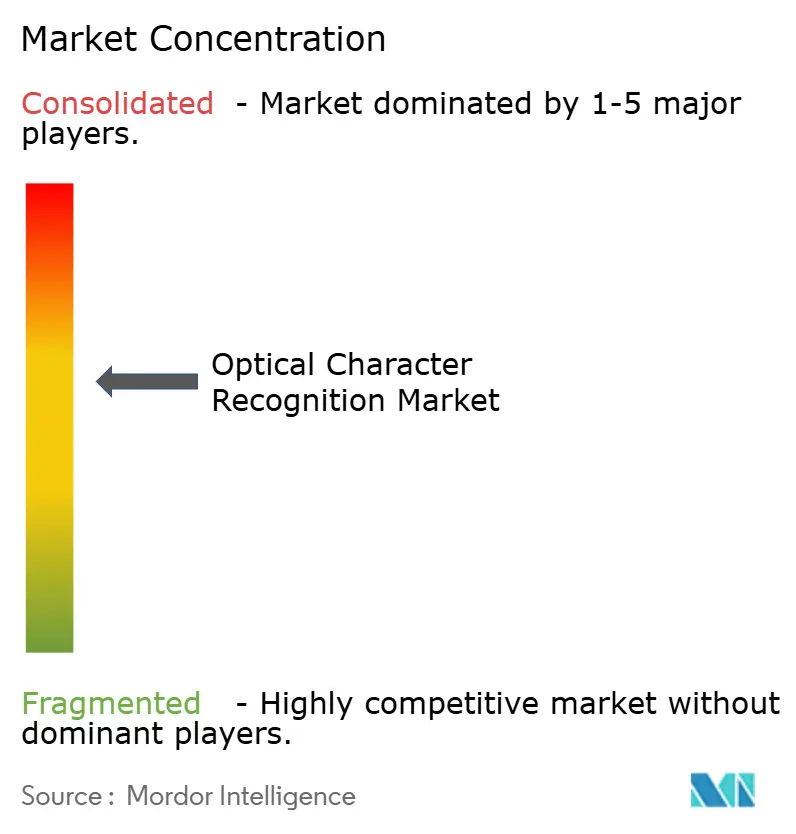
Recent Industry Developments
- April 2025: ABBYY launched an OCR API that boosts accuracy in intelligent-automation workflows, reinforcing its Everest Group leadership position.
- April 2025: OCR Studio released a WebAssembly-based engine for browser-based ID verification covering 220 jurisdictions.
- March 2025: Mistral AI introduced an OCR API processing 2,000 pages per minute at 97-99.54% accuracy across 11 languages
- March 2024: Descartes Systems Group acquired OCR Services for USD 90 million, expanding its global trade-compliance suite.
Research Methodology Framework and Report Scope
Market Definitions and Key Coverage
Our study defines the optical character recognition (OCR) market as all licensed software, embedded engines, and bundled services that transform scanned or photographed text into machine-encoded data across desktop, mobile, and cloud environments. The model counts revenue generated from initial licenses, subscription fees, and recognized implementation or managed support linked directly to OCR functionality.
Scope Exclusion: Pure handwriting-only transcription services and single-purpose barcode readers are outside this assessment.
Segmentation Overview
- By Component
- Software
- Mobile OCR Software
- Desktop OCR Software
- Cloud OCR Software
- Services
- Professional Services
- Managed Services
- Software
- By Deployment Mode
- On-Premise
- Cloud
- By Technology
- Conventional OCR
- Intelligent Character Recognition (ICR)
- Optical Mark Recognition (OMR)
- Intelligent Word Recognition (IWR)
- Others
- By Application
- Invoice and Bill Processing
- Identity Verification and KYC
- Document Management and Archiving
- Banking Cheque Processing
- Packaging and Label Recognition
- Others
- By End-Use Industry
- BFSI
- Retail and E-commerce
- Government
- Healthcare
- Education
- Transportation and Logistics
- Manufacturing
- Others
- By Geography
- North America
- United States
- Canada
- Mexico
- South America
- Brazil
- Argentina
- Rest of South America
- Europe
- Germany
- United Kingdom
- France
- Italy
- Spain
- Russia
- Rest of Europe
- Asia-Pacific
- China
- Japan
- India
- South Korea
- Australia and New Zealand
- Rest of Asia-Pacific
- Middle East and Africa
- Middle East
- Saudi Arabia
- United Arab Emirates
- Turkey
- Rest of Middle East
- Africa
- South Africa
- Nigeria
- Egypt
- Rest of Africa
- Middle East
- North America
Detailed Research Methodology and Data Validation
Primary Research
Mordor analysts interviewed OCR engine developers, system integrators, banking operations leads, and health-records administrators across North America, Europe, and Asia-Pacific. The discussions validated average selling prices, deployment preferences, and regional adoption hurdles, letting us refine assumptions that public data alone cannot surface.
Desk Research
We began by harvesting foundational indicators from open sources such as the US Census Bureau, Eurostat trade codes for image-processing software, India's MeitY export registers, and filings to the SEC and F-SAs. Patent analytics from Questel, shipment data via Volza, and news coverage indexed on Dow Jones Factiva helped us trace technology diffusion and pricing shifts. Additional context came from industry associations, AIIM for document management, NACHA for check processing volumes, and HIMSS for healthcare digitization. These references anchor baseline demand signals, while company 10-Ks and investor decks clarify monetization pathways. The sources listed are illustrative; many others informed our evidence gathering.
Market-Sizing & Forecasting
A top-down build starts with worldwide business software outlays, which are then filtered through document-intensive vertical shares and OCR penetration ratios. Select bottom-up checks, supplier roll-ups and sampled ASP × volume, for key geographies temper the totals. Critical variables include check-processing volumes, electronic medical-record mandates, mobile banking user counts, average scan resolution trends, and cloud migration rates; each was projected using ARIMA and cross-checked by multivariate regression where data series allow. Gaps in bottom-up estimates, especially for emerging markets, were bridged by applying validated adoption curves from comparable regions.
Data Validation & Update Cycle
Outputs pass variance scans against external benchmarks, peer review by a senior analyst, and a reconciliation meeting before sign-off. We refresh every twelve months, while extraordinary events, major regulatory change or landmark acquisition, trigger interim updates, ensuring clients receive the latest outlook.
Why Mordor's Optical Character Recognition Baseline Commands Reliability
Published numbers often differ because firms apply unique service scopes, pricing capture points, and refresh rhythms.
By rooting estimates in verifiable adoption metrics and cross-continent interviews, our baseline stays balanced and transparent.
Key gap drivers include narrower component coverage, untested historical extrapolations, or slower refresh cadence at other publishers.
Benchmark comparison
| Market Size | Anonymized source | Primary gap driver |
|---|---|---|
| USD 17.06 Bn (2025) | Mordor Intelligence | - |
| USD 12.56 Bn (2023) | Regional Consultancy A | Excludes services revenue and mobile OCR apps |
| USD 12.25 Bn (2024) | Trade Journal B | Relies on straight-line growth from 2020 without field validation |
| USD 12.21 Bn (2024) | Global Consultancy C | Counts only on-premise deployments; cloud uptake ignored |
The comparison shows that when we apply consistent scope choices, multi-source signals, and annual recalibration, Mordor delivers a dependable reference point that decision-makers can trace back to clear variables and repeatable steps.
Key Questions Answered in the Report
What is the current size of the optical character recognition market?
The market stands at USD 17.06 billion in 2025 and is projected to reach USD 38.32 billion by 2030.
Which segment grows fastest within the optical character recognition market?
Services grow at a 17.9% CAGR as enterprises seek implementation expertise and managed operations.
Why is identity verification a high-growth application for OCR?
Regulatory KYC mandates and digital onboarding drive adoption, propelling the segment at an 18.2% CAGR.
How are cloud deployments shaping the optical character recognition industry?
Cloud holds 66% share and enables consumption-based pricing, rapid updates, and scalability for variable volumes.
Which region leads in overall revenue?
North America leads with 40% market share due to advanced infrastructure and strong adoption in finance and healthcare.
What competitive strategies stand out among OCR vendors?
Providers focus on domain-specific templates, low-code APIs, and hybrid deployment models to differentiate beyond raw accuracy.
Page last updated on:
